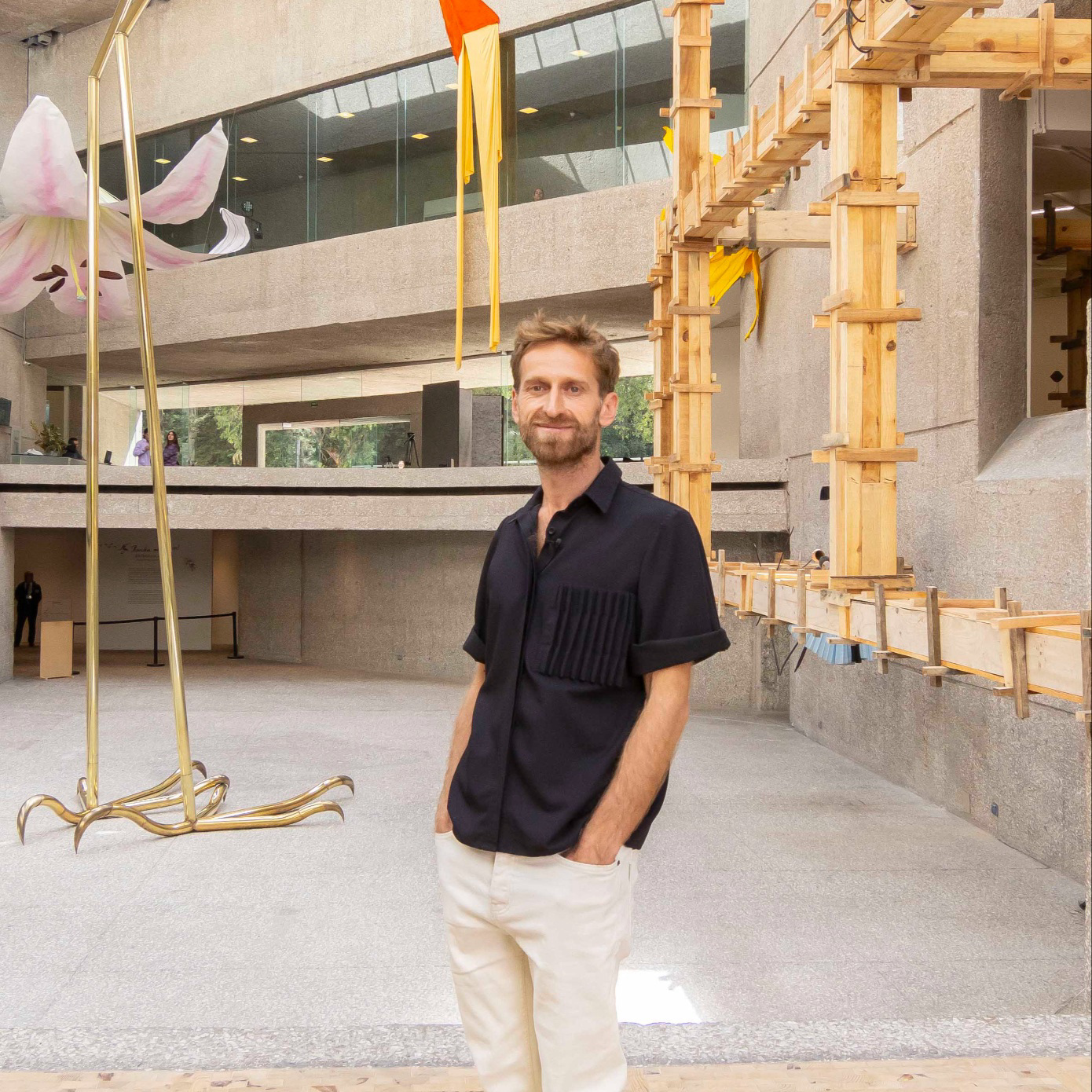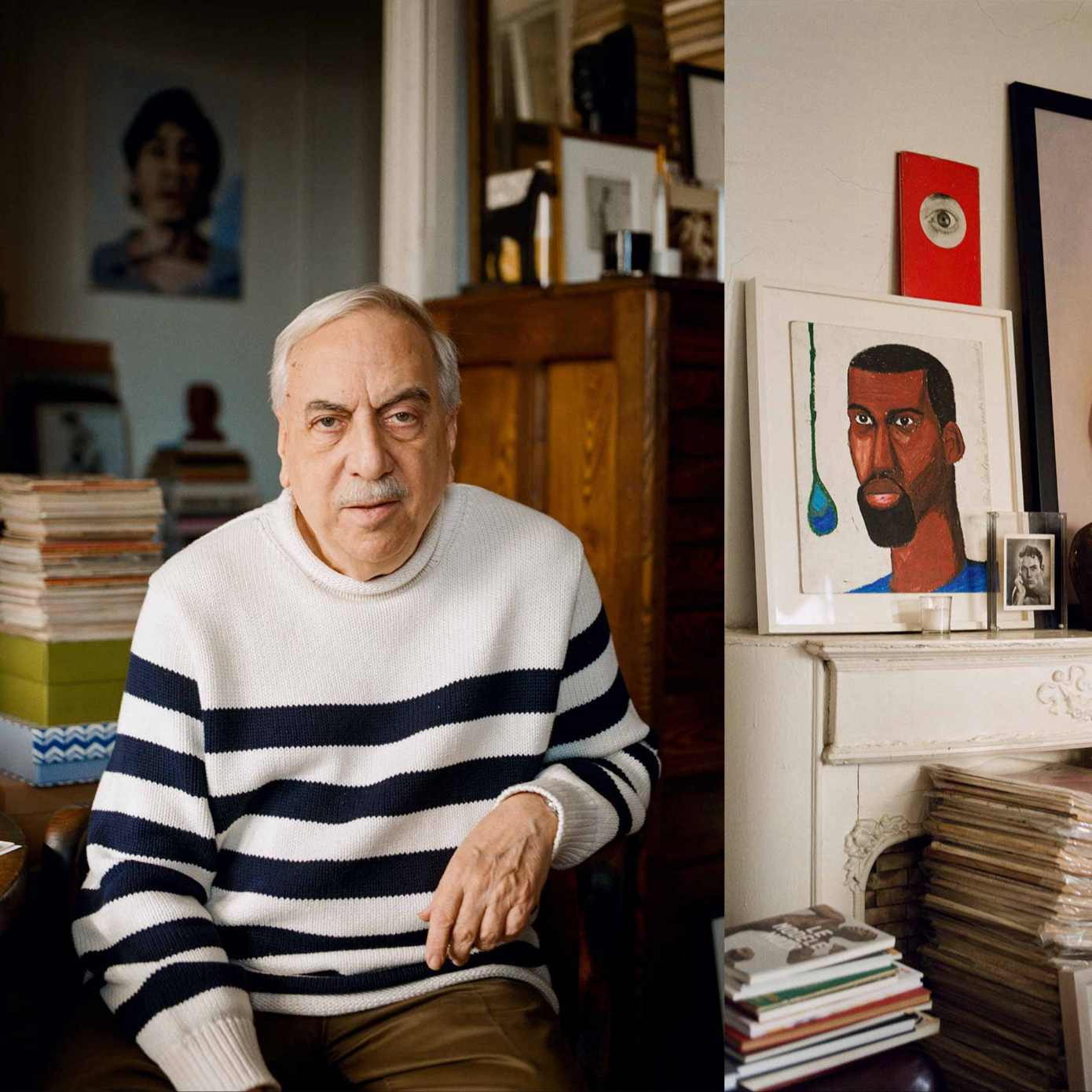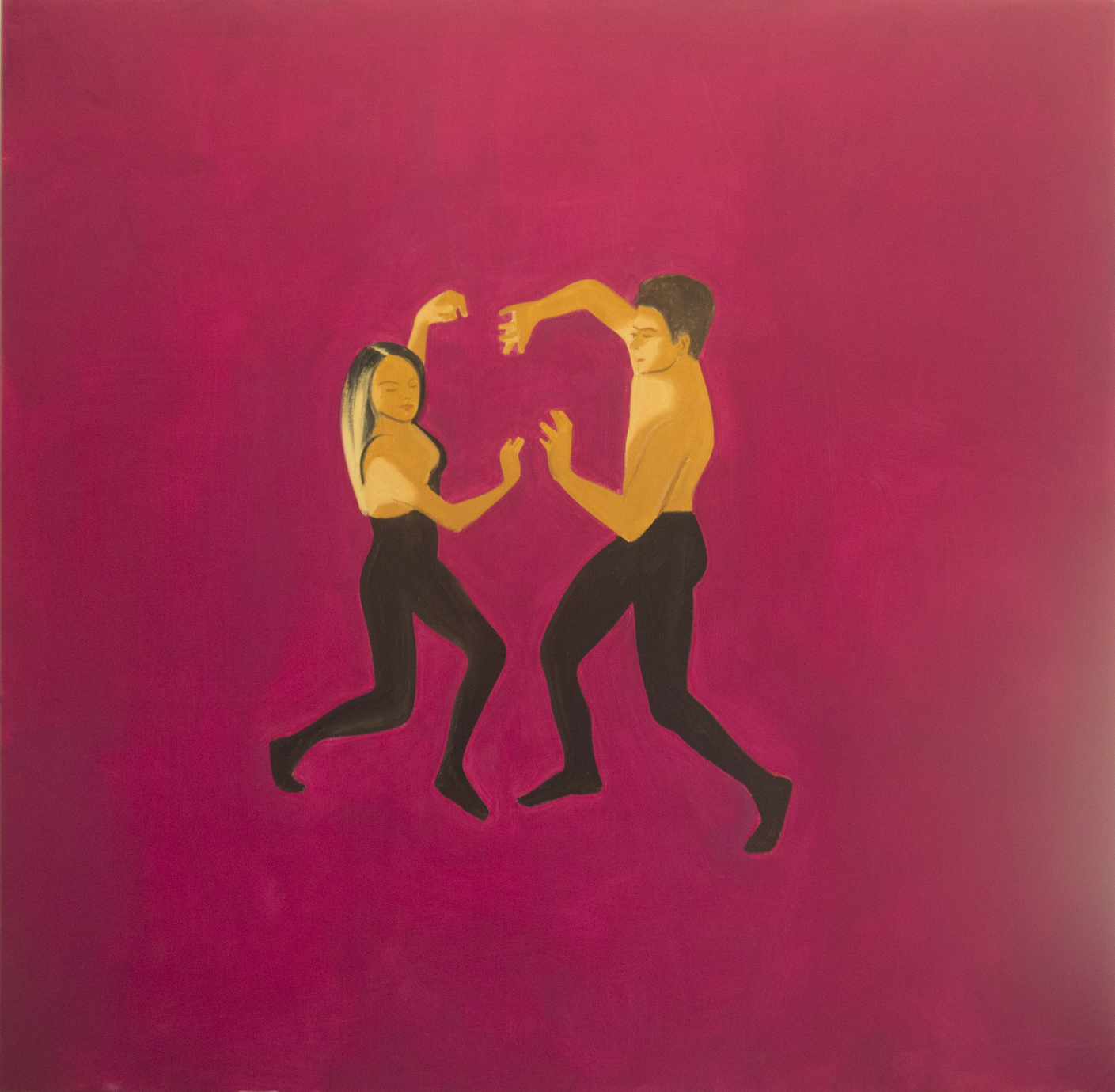
Emma McMillan spent 2013 as broke as she’d ever been, so when fellow artist Nicole Wittenberg suggested she could make some quick cash posing for the painter Alex Katz she jumped. The friendship that followed is still one of the most generative outlets McMillan enjoys. Katz too. Their almost decade-long dialogue is made up of nearly as many paintings as it is bitch sessions. The two share a love of history, especially music, dance, film, and art. They also share a packed fall calendar, with the 94-year-old Katz gearing up for a Gladstone Gallery exhibition and McMillan unveiling a multi-year commission for the Paul Rudolph Heritage Foundation’s new curatorial endeavor inspired by the biblical story of Susanna. Here the two share a snippet of their ongoing repartee with a focus on their mutual love of theater.
EMMA MCMILLAN: Is there anything you want to talk about? We can just talk about painting. I was thinking about the dancers that you were painting for the show at Tramps.
Alex Katz: I’ve been involved with dancing since the late 50s, with Paul Taylor. When you see a dancer on the stage they’re about one inch high, and what you experience in my paintings is life-size. I did a series of dancers with the torsos about four or five years ago, so this time I thought I’d do the faces and try to apply to them the emotion and experience you have when you seethe dancers on stage.
EM: All in a face, all in a portrait size.
AK: And the relationship between two people. I called up Paul Taylor, and Michael Novak, who’s another dancer, came too. I photographed them and they kept making wonderful gestures, one after the other. It’s kind of funny because when they choreograph, they take three or four hours to do a couple seconds of dance, and here they were knocking out one gesture after another. Then the hard part is deciding what I’m going to use. So I lay them on the floor and start cutting them, using tape, sorting what you need or what you don’t need. Then I painted them and decided to use green instead of the shadows.
EM: The green for the stage light, so the deepest shadows become green.
AK: Yeah, the shadows become green. I tried to use black and a purple, and it seemed kind of heavy and traditional. When I used the green, it looked right. They had a lot of stage makeup, and I did a painting 40 years ago with Paul Taylor in bright colors. There’s this woman Emma King who used to dance with the City Center—she’s Lois Dodd’s granddaughter, and she still sits like a dancer—so I told her to put on stage makeup and come over. So she did and I did these ones, four feet tall, that’s when I did the green. Then I used the Paul Taylor dancers and took the green with me, and they said oh the way King had her makeup is old-fashioned, we don’t do that anymore, we just put a little dot by the eye. I paid no attention. I put the red where she put it then I put it on the guy’s lipstick.
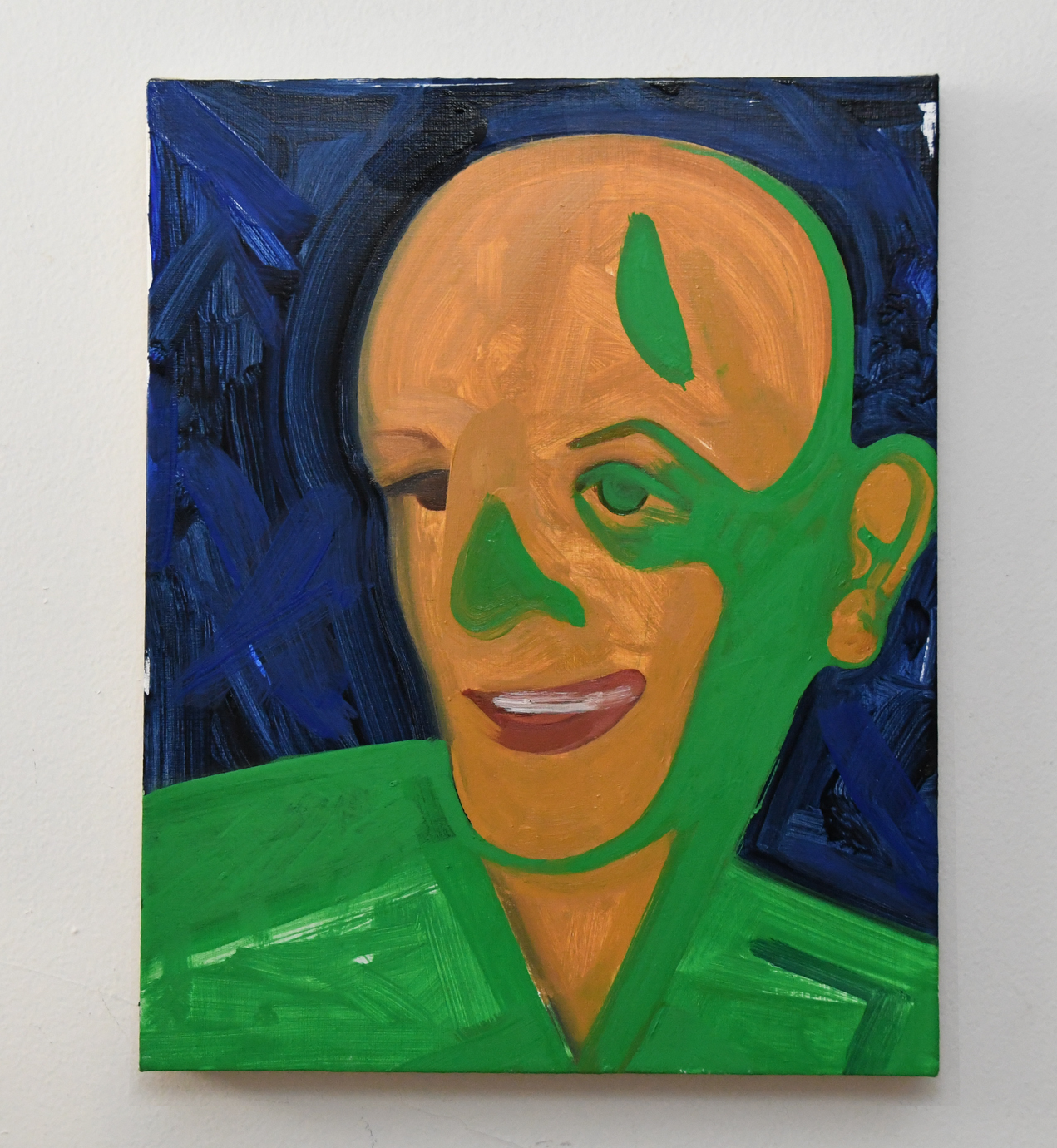
EM: His mouth in bright red lipstick.
AK: Meanwhile, I did a series with her, six of them, and worked out the green, and the colors and the big ones with violet backgrounds. I lightened the green, which made it seem like stage lighting. I was just painting things; it was kind of crazy because I would make my decisions as I was painting. It wasn’t really pre-planned. These things all work out, very mysteriously.
EM: The red comes fast, the green comes fast in these gestures—moving like on the stage!
AK: The decision is very arbitrary. I never did anything quite like it. I like the idea of showing them under a bridge. It’s the chicest place in town.
EM: You have a way of finding that!
AK: Well, I have no defense. Gavin [Brown] told me to take a look at the place, so I went and looked. It was so funny I couldn’t believe it.
EM: The paintings look really good in these office spaces.
AK: They look like a 30 year old did ‘em.
EM: Do you know the piece the dancers were performing when they were in the studio?
AK: No, they just went from one position to another. I was amazed at how many good pictures they made.
EM: And you’d done sets for ballets too, right?
AK: I did 30 years of sets.
EM: 30 years of sets!
AK: It was a lot of fun. Doing costumes and sets, it’s just as much for me—it’s like doing a painting. It’s that much energy, it’s that important.
EM: Same decisions.
AK: When you work with dance, the costumes have a life of their own, the setting has a life of its own, the dance has a life of its own. The energy is amazing. It extends way past the painting. It’s instantaneous. And the first one I did, I was absolutely shocked at the energy it made. Paul had a friend Edwin Denby, a dance critic—
EM: An amazing writer, yeah.
AK: You read his stuff?
EM: Yes, he was incredible. Rudy Burckhardt’s grandson Jakob was one of my teachers at Cooper. I learned sound composition from him, and he got me reading all of Denby.
AK: You’re lucky, then. The other one I would recommend is Balanchine’s book on Tchaikovsky. It changed my mind on Tchaikovsky; I see him through Balanchine’s eyes now. I thought Balanchine liked him because he was decorative. Balanchine liked everything around him decorative.
EM: Yeah, it’s pretty enough to be decorative but there’s something deeper.
AK: Yeah, something more. The idea was to make the sets and costumes not that good. Nothing muscular. So Robert Rauschenberg was doing stuff with Paul, and he had a table that was a still life, and the still life was attached to Paul’s back.
EM: He was very conceptual.
AK: All ideas. So Paul said, I’m not dancing like this. He said, I think Alex can do sets and costumes. I had no idea that I could, so when they asked me I had a lot of opinions about dance and staging. Martha Graham and Balanchine had the light in spots and they wanted to add value to the arts. They had all sorts of dance light, it’s not like real light.
EM: It’s acute lighting.
AK: And I said, I wanted white light, flat, so it’s like daylight. Then I made it into a collage. They have a canted stage, so you could see it. And I know the Russians never paid attention to the floor, so I made the floor bright green. Bright green on the floor, bright blue on the top. And then I put the dancers in pastel colors. I never saw it, but apparently it was okay, because Paul called me up and he asked me to do a second piece. Paul also told me to never explain anything to the lighting man, just say when you want it out, when you want it light, and when you want it down. And that was great advice, because I use that with printers; when you work with printers you don’t explain, just tell them what to do. When we performed it, the lighting man was a guy who worked for. And he did stuff in the round, he was spinning and said something like, but I’m doing it and you’re not.
EM: You wanted it flat, like a painting.
AK: Yeah, and Paul said green on one side and red on the other. And then get the colors to spin, and accelerate it. We had no money, so you had ribbons, an inch and a half, two inches—every yard was a ribbon. From the ceiling to the bottom.
EM: Oh, and Rudy Burckhardt made a movie!
AK: It’s kind of great. With one part of it, the music drops out and the colors are spinning.
EM: The box stops, but the dancers keep going. And the ribbon kind of accelerates that motion. It gives you a fast frame.
AK: Right. And they could pack the whole set into a cigar box.
EM: Roll it to the next town.
AK: That was pretty good. And I kept going with Paul; I could try all kinds of things with Paul. I once put the set across the street, it was the first timeI ever lived near people. I wanted something—you think of music as fashion, so I wanted something post-Cage. It was in the 70s, and I think that Cage was not on top at the time. It was traditional at this point, and you think fashion.
EM: He wasn’t avant-garde anymore.
AK: It was avant-garde, but it wasn’t fresh. Nothing to do with music; it was about fashion. John Ashbery had a lot of music, so we went onto his place and Paul said Beethoven, and I said you’ve got to be kidding. And then I said Brahms, that’s more like it. Then he played this record, [Iannis] Xenakis. He’s this guy who’s an architect, who worked for a producer.
EM: He made the buildings for sound.
AK: He did this stuff in Holland and the producer didn’t give him enough credit, so he said I’m going to be a musician. He made this abstract music. I remember it really sounded new. So I said let’s use that. It turned out to be a pretty good piece of music. I listened to it 30 or 40 times, it was kind of interesting. We had no idea if it would make sense; we couldn’t rehearse it, really.
EM: It just happened once.
AK: It happened on stage, opening night, looking out and saying, well, we got away with it. After that I started making sets, and they were to make something I hadn’t seen before, like killing center stage.
EM: By annihilating the focal point?
AK: Yeah, the center stage was gone. It took about 30 years, and we did it with Sunset (1982) which is the best one of all of them. I was doing a painting and I said, wouldn’t this make a great dance? Sometimes the world’s in front of you.
EM: It goes fast. Youth is done.
AK: It goes fast and it’s gone. So I said to Paul, I’d like to do this, so I added a railing and cut off a third of the stage.
EM: The railing was for the dancers to hold?
AK: Yeah, it was about 3 feet high. Behind it I painted leaves, kind of big 1930s leaves, and a plane behind that. I put the guys in beige with red hats, like soldiers, and the women I put in white dresses. Charles James did all the fitting; he sort of sculpted the dresses. Light, thin material. And my ex-wife sent me this loon music. The loon music was great, but it couldn’t cover the whole piece. So we looked for something else, and we went to John Ashbery again and found some Brahms, and Brahms was almost right. Then we got Edward Elgar’s Requiem, a great piece of music. We used loons and Elgar’s Requiem. At a certain point, it’s all bright and the guys are dancing in front of the girls and the girls are dancing with the guys.
EM: It’s very glamorous.
AK: Yeah, and then the lights go down and the loon music comes on and they all go upstage, to the corner, and the next thing you know there’s a guy and he’s being carried by the girls and the whole thing changes. The soldier. Coming down from the cross that he picked up from Caravaggio’s [Deposition of the Christ.]
EM: Oh, that’s wonderful. Jesus is upside down.
AK: He came right side up though. They take him across the stage and put him down, the lights goon and they start dancing again. And finally, the guys go off and one of them drops the hat and the girl comes over and picks it up. And that’s the end of the piece.
EM: That’s wild. That’s beautiful.
AK: They keep playing it. Really terrific piece. And the dancing was fabulous. And the girl who picked it up was a great dancer. The pause when she’s going down to pick it up was fantastic. And other dancers have done it, but none of them could do exactly as she did it.
EM: Was it hesitation?
AK: Yeah, a little hesitation. It was fantastic.
EM: Yeah, it breaks your attention. It breaks you out of it.
AK: It stops the whole thing. Well that was the end of it, we did something else, we loved the set but we couldn’t get it right. When you do theater, you have to be theatrical. People do it naturally; I’m not natural I just figure it out. We used to dye colors and we couldn’t get the colors right. Paul couldn’t care less because he’s involved with the dance, but to me the colors are very important. So I said, they’re not right and tomorrow it’s going on, so I’ve got to go in there and throw the costumes on the floor as hard as I can, and if it’s not fixed by tomorrow you’ll never see me again.
EM: You’re speaking their language! You have to be a diva.
AK: They fixed it. It was a lot of fun.
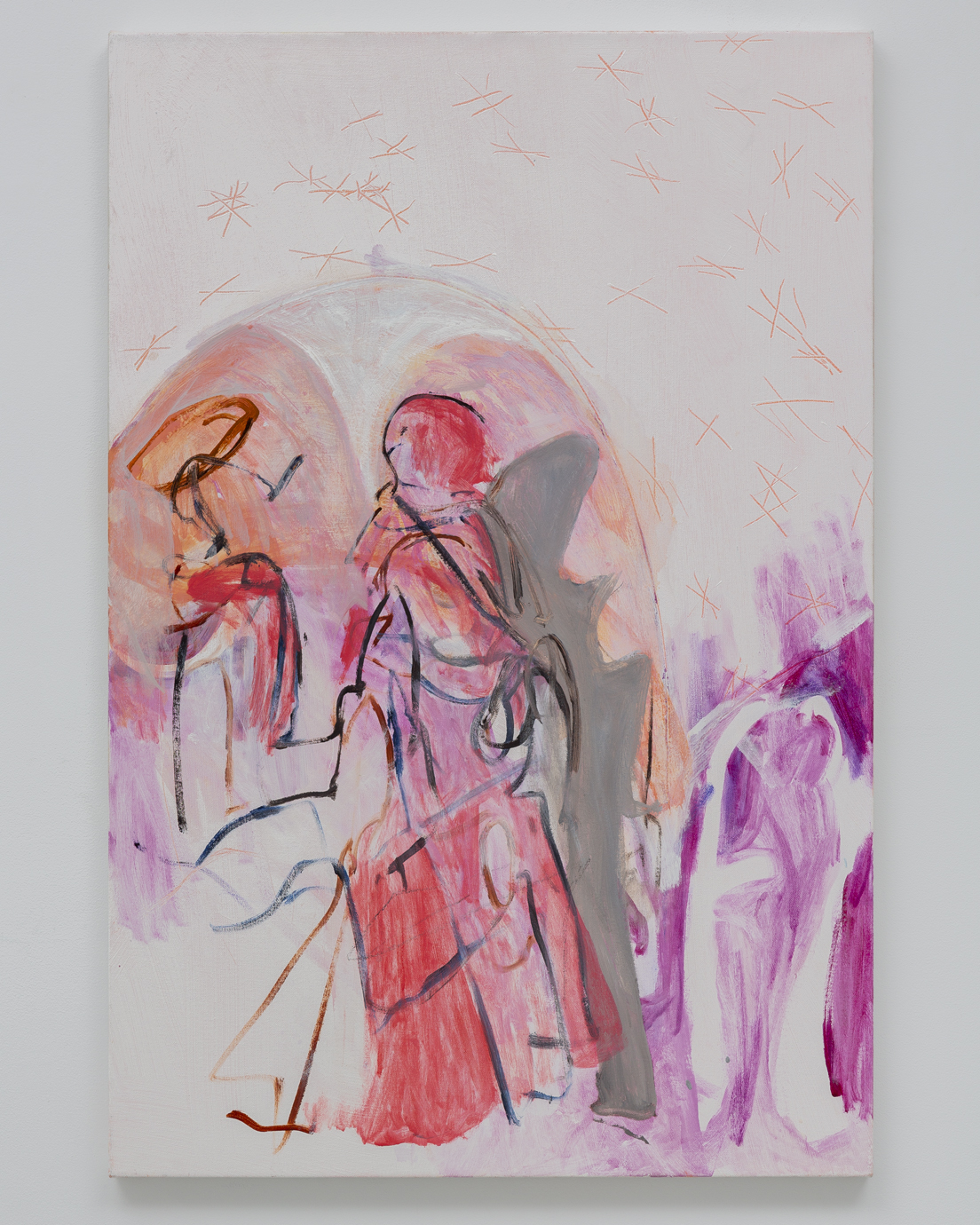
EM: Do you think about choreography in your non-dancer paintings?
AK: Well, gesture and motion are important. That’s been my hand from the beginning. I think the paintings are about time and light.
EM: It’s theater. You’re moving more than you ever had, with the new ones.
AK: It goes way back. With the dancers I was always involved with movement. I did that in the ‘60s. But also the gestures that are of our time, like smoking a cigarette was in my time. And there’s no history of that in painting. So you get into gestures that belong to your time, not anyone else’s.
EM: The selfie.
AK: Well you’re trying to get the immediate present. That’s what the idea is. When I was young, I read a Reubens book. The teacher told me to get it. I just fell in love with the Impressionist painting, it never left my system. Soft and gentle, and I like the lighting of de Kooning and Kline, it’s very immediate. I wanted to paint a lot like de Kooning or Kline or Pollock, where it’s really quick, unlike Impressionist painting. Then it becomes this sensation of seeing something faster than you can think. I’m trying to paint that, and you can’t do it and you can’t make a realistic painting, because realistic is not what most people believe—realism is a variable, it keeps changing.
EM: It’s in your mind.
AK: In anyone’s mind. You see things culturally, not through your head but through your culture, and the culture keeps changing and people’s idea of what’s realistic keeps changing. If I’m trying to do something realistic, I know it’s going to be obsolete in 40 years, just as Rembrandt’s realism is obsolete.
EM: So was Rembrandt fashionable?
AK: Moderately fashionable, because there was Reubens at the same time, and Reubens was making 1930 Cadillacs.
EM: Big, wide hips.
AK: He had a whole thing. My brother once had a Cadillac convertible, red with black leather seats. So I said something about, why don’t you get something better like a Bentley? And he said where can you get something with this much jazz for the money? And that’s Reubens.
EM: I think Rembrandt would be a horse-drawn carriage. Something a little downcast.
AK: In art school, a history teacher told us Picasso is like Reubens and Rouault is like Rembrandt. Rouault is a greater artist than Picasso.
EM: That’s a lot to think about.
AK: For me, Rouault paints technically very nicely, but it’s so fucking heavy.
EM: It’s heavy and very linear.
AK: Kind of corny. And I don’t think of Reubens as being corny. He’s just big and you see some good Rubens, the whole idea becomes ridiculous. He’s got so much pizzazz.
EM: It’s very soft and playful.
AK: He does motion real well. More motion than image. Bill de Kooning is like Reubens, the images aren’t so hot but the motion’s great.
EM: It’s wonderful. Just thinking about the space around the figures with Reubens. You don’t think about the negative space.
AK: It’s not a picture. Rousseau and Dali, they made images. You can’t forget the image.
EM: Things are activated and moving off each other kinetically.
AK: I find I’m an image maker, I make images. And if you paint it real well, it has power. More power.
EM: Have you ever read this movie critic, André Bazin? He was a surrealist film critic. He’s all about the psychology of film. He was a Freudian and he was all about how similarly the way the mind absorbs image before culture, before anything.
AK: The first blast of an image.
EM: Yes, he’s all about that first blast and the free association of the surrealists.
AK: When I went to art school, the prevalent thing was Freud and communism. And a couple of other things I found horribly uninteresting.
EM: Communism’s horribly boring.
AK: Freud was very boring to me. I was interested in jazz and basketball. And dancing. We’d go to the Palladium dancing. That was interesting to me.
EM: That’s before discotheque, so was it like band music?
AK: Yeah, they had this live Afro-Cuban stuff with Machedo. They would take the whole audience and blow it apart. He was unreal.
EM: That’s fantastic. Freud doesn’t dance after all.
Craving more culture? Sign up to receive the Cultured newsletter, a biweekly guide to what’s new and what’s next in art, architecture, design and more.

